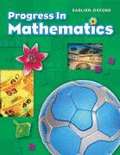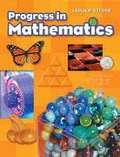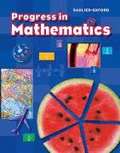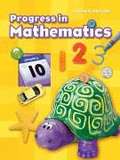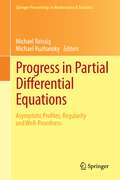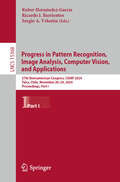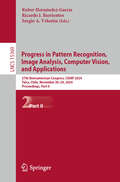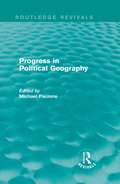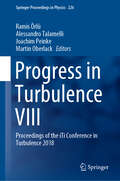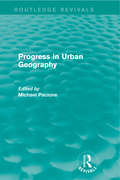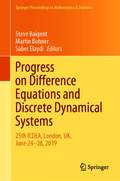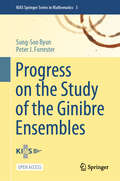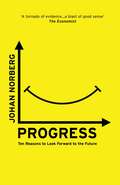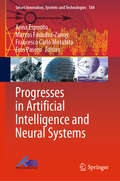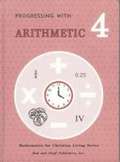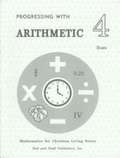- Table View
- List View
Progress in Mathematics [Grade 1]
by Alfred Posamentier Catherine Letourneau Elinor FordA publisher-supplied textbook
Progress in Mathematics [Grade 1]
by Elinor R. Ford Alfred S. Posamentier Catherine D. LetourneauA publisher-supplied textbook
Progress in Mathematics [Grade 2]
by Alfred Posamentier Catherine Letourneau Elinor FordA publisher-supplied textbook
Progress in Mathematics [Grade 2]
by Elinor R. Ford Alfred S. Posamentier Catherine D. LetourneauA publisher-supplied textbook
Progress in Mathematics [Grade 3]
by Alfred Posamentier Catherine Letourneau Elinor FordA publisher-supplied textbook
Progress in Mathematics [Grade 3]
by Elinor R. Ford Alfred S. Posamentier Catherine D. LetourneauA publisher-supplied textbook
Progress in Mathematics [Grade 4]
by Alfred Posamentier Catherine Letourneau Elinor FordA publisher-supplied textbook
Progress in Mathematics [Grade 4]
by Elinor R. Ford Alfred S. Posamentier Catherine D. LetourneauA publisher-supplied textbook
Progress in Mathematics [Grade 5]
by Alfred Posamentier Catherine Letourneau Elinor FordA publisher-supplied textbook
Progress in Mathematics [Grade 5]
by Elinor R. Ford Alfred S. Posamentier Catherine D. LetourneauA publisher-supplied textbook
Progress in Mathematics [Grade 6]
by Elinor R. Ford Alfred S. Posamentier Catherine D. LetourneauA publisher-supplied textbook
Progress in Mathematics [Grade K]
by Alfred Posamentier Catherine Letourneau Elinor FordA publisher-supplied textbook
Progress in Mathematics [Grade K]
by Elinor R. Ford Alfred S. Posamentier Catherine D. LetourneauA publisher-supplied textbook
Progress in Partial Differential Equations
by Michael Ruzhansky Michael ReissigProgress in Partial Differential Equations is devoted to modern topics in the theory of partial differential equations. It consists of both original articles and survey papers covering a wide scope of research topics in partial differential equations and their applications. The contributors were participants of the 8th ISAAC congress in Moscow in 2011 or are members of the PDE interest group of the ISAAC society. This volume is addressed to graduate students at various levels as well as researchers in partial differential equations and related fields. The readers will find this an excellent resource of both introductory and advanced material. The key topics are: * Linear hyperbolic equations and systems (scattering, symmetrisers) * Non-linear wave models (global existence, decay estimates, blow-up) * Evolution equations (control theory, well-posedness, smoothing) * Elliptic equations (uniqueness, non-uniqueness, positive solutions) * Special models from applications (Kirchhoff equation, Zakharov-Kuznetsov equation, thermoelasticity)
Progress in Pattern Recognition, Image Analysis, Computer Vision, and Applications: 27th Iberoamerican Congress, CIARP 2024, Talca, Chile, November 26–29, 2024, Proceedings, Part I (Lecture Notes in Computer Science #15368)
by Ruber Hernández-García Ricardo J. Barrientos Sergio A. VelastinThis two-volume set LNCS 15368-15369 constitutes the refereed proceedings of the 27th Iberoamerican Congress on Progress in Pattern Recognition, Image Analysis, Computer Vision, and Applications, CIARP 2024, held in Talca, Chile, during November 26-29, 2024. The 35 full and 3 short papers presented in these proceedings were carefully reviewed and selected from 61 submissions. The papers presented in these two volumes are clustered into various thematical issues as follows: Part I: Mathematical methods and computing techniques for artificial intelligence and pattern recognition, bioinformatics. Part II: Biometrics, cognitive and humanoid vision, computer vision, image analysis, intelligent data analysis.
Progress in Pattern Recognition, Image Analysis, Computer Vision, and Applications: 27th Iberoamerican Congress, CIARP 2024, Talca, Chile, November 26–29, 2024, Proceedings, Part II (Lecture Notes in Computer Science #15369)
by Ruber Hernández-García Ricardo J. Barrientos Sergio A. VelastinThis two-volume set LNCS 15368-15369 constitutes the refereed proceedings of the 27th Iberoamerican Congress on Progress in Pattern Recognition, Image Analysis, Computer Vision, and Applications, CIARP 2024, held in Talca, Chile, during November 26-29, 2024. The 35 full and 3 short papers presented in these proceedings were carefully reviewed and selected from 61 submissions. The papers presented in these two volumes are clustered into various thematical issues as follows: Part I: Mathematical methods and computing techniques for artificial intelligence and pattern recognition, bioinformatics. Part II: Biometrics, cognitive and humanoid vision, computer vision, image analysis, intelligent data analysis.
Progress in Political Geography (Routledge Revivals)
by Michael PacioneSince the 1970s, the field of political geography has undergone a significant transformation, where new methodologies have been implemented to investigate the exercise of the power of the state within the urban environment. First published in 1985, the essays in this collection addressed the growing need to assess the academic revisions that had been taking place and provide a reference point for future developments in the discipline. Still of great relevance, the essays consider the most prominent themes in areas of key importance to political geography, including theory and methodology, minority groups, local government and the geography of elections. This volume will be of significant value for students of political geography, urban demography and town planning.
Progress in Turbulence VIII: Proceedings of the iTi Conference in Turbulence 2018 (Springer Proceedings in Physics #226)
by Joachim Peinke Martin Oberlack Alessandro Talamelli Ramis ÖrlüThis volume collects the edited and reviewed contributions presented in the 8th iTi Conference on Turbulence, held in Bertinoro, Italy, in September 2018. In keeping with the spirit of the conference, the book was produced afterwards, so that the authors had the opportunity to incorporate comments and discussions raised during the event. The respective contributions, which address both fundamental and applied aspects of turbulence, have been structured according to the following main topics: I TheoryII Wall-bounded flowsIII Simulations and modellingIV ExperimentsV Miscellaneous topicsVI Wind energy
Progress in Urban Geography (Routledge Revivals)
by Michael PacioneA substantial proportion of the world’s population now live in towns and cities, so it is not surprising that urban geography has emerged as a major focus for research. This edited collection, first published in 1983, is concerned with the effects on the city of a wide range of economic, social and political processes, including pollution, housing, health and finance. With a detailed introduction to the themes and developments under discussion written by Michael Pacione, this comprehensive work provides an essential overview for scholars and students of urban geography and planning.
Progress on Difference Equations and Discrete Dynamical Systems: 25th ICDEA, London, UK, June 24–28, 2019 (Springer Proceedings in Mathematics & Statistics #341)
by Martin Bohner Saber Elaydi Steve BaigentThis book comprises selected papers of the 25th International Conference on Difference Equations and Applications, ICDEA 2019, held at UCL, London, UK, in June 2019. The volume details the latest research on difference equations and discrete dynamical systems, and their application to areas such as biology, economics, and the social sciences. Some chapters have a tutorial style and cover the history and more recent developments for a particular topic, such as chaos, bifurcation theory, monotone dynamics, and global stability. Other chapters cover the latest personal research contributions of the author(s) in their particular area of expertise and range from the more technical articles on abstract systems to those that discuss the application of difference equations to real-world problems. The book is of interest to both Ph.D. students and researchers alike who wish to keep abreast of the latest developments in difference equations and discrete dynamical systems.
Progress on the Study of the Ginibre Ensembles (KIAS Springer Series in Mathematics #3)
by Peter J. Forrester Sung-Soo ByunThis open access book focuses on the Ginibre ensembles that are non-Hermitian random matrices proposed by Ginibre in 1965. Since that time, they have enjoyed prominence within random matrix theory, featuring, for example, the first book on the subject written by Mehta in 1967. Their status has been consolidated and extended over the following years, as more applications have come to light, and the theory has developed to greater depths. This book sets about detailing much of this progress. Themes covered include eigenvalue PDFs and correlation functions, fluctuation formulas, sum rules and asymptotic behaviors, normal matrix models, and applications to quantum many-body problems and quantum chaos. There is a distinction between the Ginibre ensemble with complex entries (GinUE) and those with real or quaternion entries (GinOE and GinSE, respectively). First, the eigenvalues of GinUE form a determinantal point process, while those of GinOE and GinSE have the more complicated structure of a Pfaffian point process. Eigenvalues on the real line in the case of GinOE also provide another distinction. On the other hand, the increased complexity provides new opportunities for research. This is demonstrated in our presentation, which details several applications and contains not previously published theoretical advances. The areas of application are diverse, with examples being diffusion processes and persistence in statistical physics and equilibria counting for a system of random nonlinear differential equations in the study of the stability of complex systems.
Progress: Ten Reasons to Look Forward to the Future
by Johan NorbergA Book of the Year for The Economist and the Observer Our world seems to be collapsing. The daily news cycle reports the deterioration: divisive politics across the Western world, racism, poverty, war, inequality, hunger. While politicians, journalists and activists from all sides talk about the damage done, Johan Norberg offers an illuminating and heartening analysis of just how far we have come in tackling the greatest problems facing humanity. In the face of fear-mongering, darkness and division, the facts are unequivocal: the golden age is now.
Progresses in Artificial Intelligence and Neural Systems (Smart Innovation, Systems and Technologies #184)
by Anna Esposito Marcos Faundez-Zanuy Francesco Carlo Morabito Eros PaseroThis book provides an overview of the current advances in artificial intelligence and neural nets. Artificial intelligence (AI) methods have shown great capabilities in modelling, prediction and recognition tasks supporting human–machine interaction.At the same time, the issue of emotion has gained increasing attention due to its relevance in achieving human-like interaction with machines. The real challenge is taking advantage of the emotional characterization of humans’ interactions to make computers interfacing with them emotionally and socially credible.The book assesses how and to what extent current sophisticated computational intelligence tools might support the multidisciplinary research on the characterization of appropriate system reactions to human emotions and expressions in interactive scenarios. Discussing the latest recent research trends, innovative approaches and future challenges in AI from interdisciplinary perspectives, it is a valuable resource for researchers and practitioners in academia and industry.
Progressing With Arithmetic Grade 4
by Lester Miller Timothy Conley Sandra BaumanThis hardcover textbook has 170 lessons, counting tests. Teaches the multiplication and division facts 10's-12's, long division, multiplying by 2-digit numbers, and checking. Reading problem skills include distance-rate-time, 2-step problems, using sketches, and identifying missing information. Also covers place value, decimals, Roman numerals, scale drawings, metric units of length, fractions, geometry, and graphs.
Progressing with Arithmetic Grade 4 Tests (Mathematics for Christian Living Series)
by Rod Staff PublishersThis is a test booklet for Grade 4 Math.

